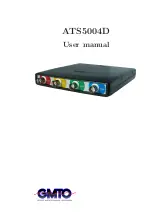
Figure 3.2: Differential input
A differential input is not referenced to ground, but both sides
of the input are ”floating”. It is therefore possible to connect one
side of the input to one point in the circuit and the other side of
the input to the other point in the circuit and measure the voltage
difference directly.
Advantages of a differential input:
•
No risk of creating a short circuit to ground
•
Only one channel is required to measure the signal
•
More accurate measurements, since only one channel intro-
duces a measurement error
•
The CMRR of a differential input is high. If both points have
a relative high voltage, but the voltage difference between the
two points is small, the voltage difference can be measured
in a low input range, resulting in a high resolution
3.1.1
Differential attenuators
To increase the input range of the ATS5004D, it comes with a
differential 1:10 attenuator for each channel. This differential at-
tenuator is specially designed to be used with the ATS5004D.
Figure 3.3: Differential attenuator
For a differential input, both sides of the input need to be at-
tenuated.
Introduction
7
Summary of Contents for GMTO ATS5004D
Page 1: ...ATS5004D User manual...
Page 6: ...2 Chapter 1...
Page 24: ...Figure 4 8 Driver install Finished 20 Chapter 4...
Page 30: ...26 Chapter 5...
Page 32: ...28 Chapter 6...
Page 41: ......


























